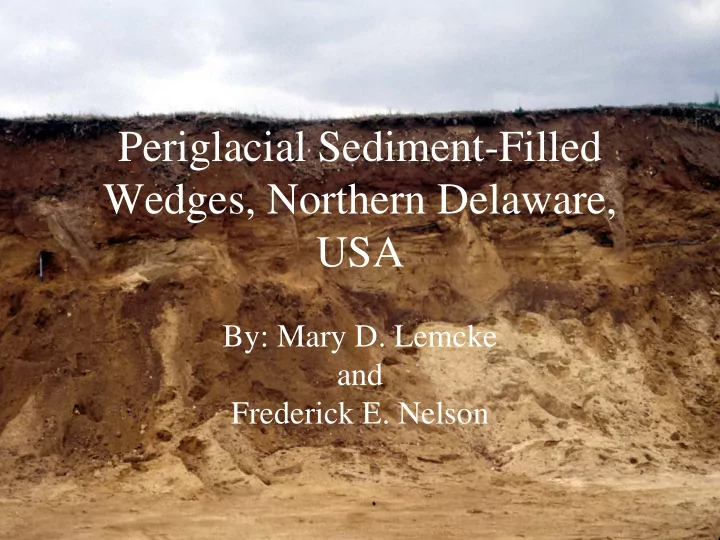

Periglacial Sediment-Filled Wedges, Northern Delaware, USA By: Mary D. Lemcke and Frederick E. Nelson
Relict periglacial features associated with Late Quaternary glaciations have been used to reconstruct the periglacial environment south of the glacial border (Brown and Péwé, 1973; Washbrun, 1980, Péwé, 1983) Project goals: To determine the origin of wedge-like sediment-filled structures in northern Delaware, we generically refer to as “sediment-filled wedges”, and determine their possible paleoenvironmental significance.
40 Pennsylvania New Jersey Maryland DELDOT Sand and 39.5 Gravel Pit, Middletown Sand and Gravel Pit, Kenton 39 Delaware 38.5 38 -76.5 -76 -75.5 -75 -74.5 Map of northern Delaware showing the locations of the DELDOT sand and gravel pit south of Middletown and the privately owned sand and gravel pit near Kenton.
60 50 Grain-size distribution of sediment 40 samples from a typical wedge structure % 30 from the Middletown quarry and the 20 only wedge from the Kenton quarry 10 0 -2 -1 0 1 2 3 4 5 phi scale Middletow n Kenton 60 50 Grain-size distribution of samples 40 taken from the top, middle, and % 30 bottom of a wedge from the 20 Middletown quarry 10 0 -1 0 1 2 3 4 5 phi scale top middle bottom
Non-Periglacial Origins: Periglacial Origins: -Nonthermal Tension Cracks -Ice Wedge Casts -Desiccation Cracks -Calcite-Filled -Composite Wedge Casts -Lenticular -Vertically Foliated -Primary Sand Wedges -Seismic Features -Loading -Frost Wedges -Diapirism -Sedimentary Dikes -Small Faults -Water Escape Structures -Soil Fingers
Criteria for Wedges Formed in Permafrost Dylik and Maarleveld (1967) Murton, Worsley, and Gozdzik (2000) 1. Maximum width exceeding 10 cm 1. Large-scale polygonal network 2. Rapid decrease of width downward 2. Vertical to steeply dipping lamination 3. Infill material different than 3. Elementary sand veins extending from surrounding material sides and toes of sand wedges 4. Bending of layers along wedge wall 4. Inclusions of host material cross-cut by sand veins 5. Swellings bordering top of wedge 5. Pebbles near top of wedge, gravel 6. Polygonal pattern exceeding 7 m in content decreases with depth diameter Ventifact lags 6. 7. Distance between wedges of several meters 7. Infill indicates greater aeolian abrasion than that of host material
41 Lewisburg Benfer South Bound Brook Manville 40.5 Pennsylvania New Jersey 40 West Berlin 39.5 Middletown Maryland Kenton Haleyville Pollack's Farm 39 Delaware 38.5 -77.5 -77 -76.5 -76 -75.5 -75 -74.5 -74 Map of the mid-Atlantic region showing the locations of sediment-filled wedges ( ▼ indicates the location of reported relict sand and frost wedges and field located sediment-filled wedges; ▽ indicates the location of reported ice-wedge casts).
In Conclusion… The sediment-filled wedges located near Middletown and Kenton, Delaware, are morphologically and sedimentologically similar to wedges formed by thermal contraction cracking and filled with aeolian sediments. ------------------------------------------------------------------------------ The morphology and size of the wedges along with other paleoenvironmental information indicate that permafrost was present during their formation. Although the exact time in which the wedges formed has yet to be determined, based on ancillary evidence, we can infer that they formed during the peak of the last ice age.
Future Research • A more accurate age for the sediment-filled wedges would provide us with more specific information about the environment in which the wedges formed and could be determined using thermoluminescence or optically stimulated luminescence dating. • A broader search for similar features would enhance our knowledge of the geographic extent of the environment in which the wedges formed.
ACKNOWLEDGEMENTS We are grateful to Dr. Thomas Meierding and Dr. Kelvin Ramsey for providing critical expertise in developing the thesis from which this paper was distilled. Jim Doolittle (U.S. Department of Agriculture) conducted ground penetrating radar investigations and provided interpretive expertise. Jim Black and the Department of Geology (University of Delaware), Dr. Robert Jordan, Dr. Scott Andres, and the Delaware Geological Survey made laboratory equipment available and discussed local geology with the first author.
Periglacial Sediment-Filled Wedges, Northern Delaware, USA By: Mary D. Lemcke and Frederick E. Nelson
Recommend
More recommend